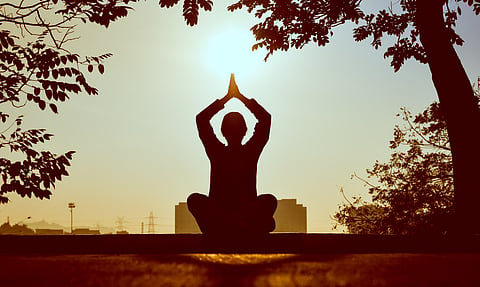
- HOME
- TRENDING
- PEOPLE
- COMMUNITY
- LIFESTYLE
- OUR PUBLICATIONSOUR PUBLICATIONS
- MASALA RECOMMENDS
- MASALAWEDS

(Re)treat yourselves and discover which form of meditation you resonate with the most.
By Natasha Sethi
Meditation is a form of self-care and wellness that is becoming more prevalent than ever. Over the past year, numerous people have made the conscious decision to indulge in meditation, whether it be at home, wellness retreat centres, or both. So if you're feeling the weight of pandemic woes, worry not as we've compiled a list of four types of meditation to consider, and which retreats to visit to try them.
VIPASSANA MEDITATION
Vipassana meditation is an ancient technique; in fact, it's rumoured to be the oldest Buddhist meditation practice to exist. Originally from and taught in India, it is now practiced by many around Thailand. Also known as 'insight meditation,' Vipassana essentially means to 'see things as they really are'. It aims to train your mind and body to be as aware as possible of your life experiences by attentive listening, mindful seeing, and careful testing, creating a lifelong journey of self-discovery. This introspection is achieved by encouraging practitioners to focus on their breath and/or physical sensations to help pacify the mind and in order to familiarise yourself with certain aspects of life. This form of meditation is gentle, yet extremely assiduous.
Thailand is now known for some of the best Vipassana meditation retreats. We recommend S.N. Goenka Meditation Center and Dipabhavan Meditation Center. www.dhani.dhamma.org
MINDFULNESS MEDITATION
As the name itself suggests, this form of meditation trains people to be more mindful, referring to the mental state of being fully aware of the present and accepting it in a peaceful manner. Ergo, practicing this meditation assists in making us fully present by being cognisant of our surroundings and actions. You can start being more mindful simply by paying attention to your thoughts, senses, and emotions when performing daily tasks. Mindfulness is something that can be implemented all day and not just during formal meditation – meditation is a practice, while mindfulness is the result.
Follow these steps: take a seat on a stable and solid surface, crossing your legs or allowing your feet to touch the floor if sat on a higher surface; straighten your back, allowing yourself to close your eyes or keep them open depending on your preference; and focus on the action of inhaling and exhaling. Gently return your attention to your breath if and when your mind wanders and do this for as long as you need to. When you feel ready, bring your attention back to the present.
A few retreats that practice mindfulness meditation are Kamalaya Koh Samui (www.kamalaya.com) and Flow Yoga Chiang Mai (flow-yoga-cnx.business.site)
MOVEMENT MEDITATION
Sitting meditation may not work for everyone; maybe you're a restless person or the thought of it is unexciting, or you just don't resonate with it. A productive alternative for you may be movement (also known as dynamic or active) meditation, which is exactly what it sounds like. Yes, it's a thing and it might just be your thing!
It revolves around moving your body in a way that feels natural in order to encourage your mind to quiet down, and therefore can be practiced anywhere, at any time. The principal point to bear in mind is being as mindful as you can during your movements. A few tips to get you started: use your breath to guide your movements and move in a way that you are familiar with, using those movements to create awareness. Examples include walking, dancing, cleaning, and even just being at the beach.
Check out DANCEmandala School for Movement Meditation (Facebook: @DANCEmandala)
GUIDED MEDITATION
Ever tried meditating, but your mind keeps wandering and distractions seem inevitable? Guided meditation addresses this hindrance through the guidance of a teacher, an edified practitioner, or a narrator. This form of meditation can be practiced either in person or from the comfort of your own home via audio and/or video and could be particularly beneficial to you if you're a newbie and you're struggling with unguided meditation. Telling you how to position your body, explaining how the mind works, and assisting in the avoidance of diversions are some of the aspects guided meditation ushers you through. Gratitude, open awareness, and mantra meditation are some of its key techniques.
An app we recommend is Headspace. For in-person sessions, check out Phuket Cleanse (www.phuketcleanse.com) and The International Buddhist Meditation Center (www. discoverythailand.com/Bangkok_International_Buddhist_ Meditation_Centre__I.B.M.C._.asp)
THE COMMUNITY WEIGHS IN
SROSHA KHANIJOU
"My father's experiences with meditation nurtured my fascination for Dharma. I attended my first 10-day S.N. Goenka Dharma discourse at 17 years of age, where I learned not only how to meditate, but also why to meditate. The not-talking for nine days was particularly difficult for me as I'm rather talkative, but it was worth it. The two courses I've attended helped me understand the truth of my behaviors."
AMRITPAL SINGH SETHI
"Vipassana helps declutter our mind and provides us with clarity on our actions. It helped me in terms of concentration and focusing on the present, rather than the past. This meditation has taught me that everything can be solved and that once you calmly accept reality as it is, happiness shall prevail."